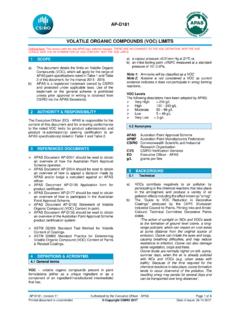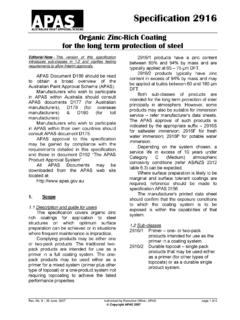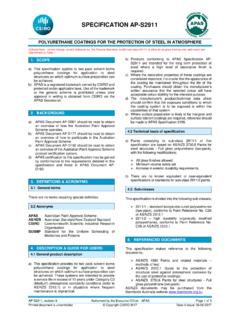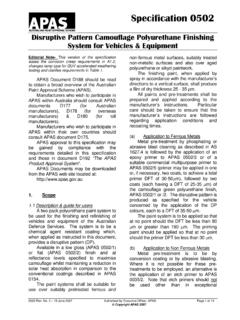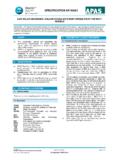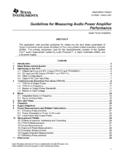Transcription of SPECIFICATION AP-S0041 - APAS
1 SPECIFICATION AP-S0041 PAVEMENT MARKING MATERIALS AP-S0041 v10 Printed versions of this document are Uncontrolled Issue date: 16/10/2015 Page 1 of 6 [ ] Copyright CSIRO 2015 Editorial Note This version of the SPECIFICATION clarifies requirements for runway, apron & taxiway markings for 0041/6;. 1. SCOPE a) This SPECIFICATION applies to coatings designed to be applied to various pavement surfaces bituminous (asphalt or spray seal) or concrete roads, car parks, airport runways in order to increase the safe use of the pavement. b) Safe use of these surfaces is facilitated through the use of brighter lines to separate traffic (major & minor roads), introduce order (car parks, public spaces) or delineate spaces (roads and airport runways). c) apas is a registered trademark owned by CSIRO and protected under applicable laws. Use of the trademark or the general scheme is prohibited unless prior approval in writing is obtained from CSIRO via the apas Secretariat.
2 2. BACKGROUND a) apas document D001 should be read to obtain a broad overview of the Australian Paint Approval Scheme ( apas ). b) Manufacturers who wish to participate in apas within Australia should consult apas documents D177. c) apas approval to this SPECIFICATION may be gained by compliance with the requirements detailed in this SPECIFICATION and those in document D192. 3. DESCRIPTION & GUIDE FOR USERS General product description a) Pavement markings are used to improve the safe use of roads and other surfaces carrying all manner of traffic, from pedestrians to cyclists to vehicles and planes. These pavements are an important part of the national infrastructure system. b) Historically solvent based paints were used for line marking (alkyd or chlorinated rubber) but in recent time water based coatings (acrylics) have become the dominant pavement marking.
3 This is due to their speed of dry, ability to provide no-pick up properties and a superior ability to adhere to glass beads thereby providing crucial retroreflectivity in wet night conditions. Note A: Glass beads are accredited by apas under SPECIFICATION apas SPECIFICATION AP-S0042. c) A secondary benefit of water borne pavement marking paints is their lower impact on the environment and on human health and safety. d) Thermoplastic markings are also common. These are single component products that can either be applied hot (by extrusion or screed methods) or cold (pre-formed markings). e) In addition to the thermoplastic and water and solvent based paints used, specialty two-pack products are also used and these may be applied by either extrusion or screed methods. f) Cold applied plastic materials are classified by three modes of application i). Class A roller/squeegee applied ii).
4 Class B trowel/screed box applied iii). Class C spray applied two component g) 0041/6 airport markings are typically used on three distinct areas of airports; i). Runway markings for the actual touchdown/take off areas. To maximise slip resistance, glass beads are not used and markings have a degree of self-cleaning properties. ii). Taxiway markings pavement areas that allow the aircraft to move between Runway and Apron. Typically these markings are yellow and similar to standard water borne pavement marking products iii). Apron markings parking areas for planes and equipment and includes airside roads. Markings are typically available in multiple colours white, yellow, red, black some or all of which may have glass beads applied and are equivalent to standard waterbased pavement marking paints. Sub-classes This SPECIFICATION is divided into the following sub-classes; 0041/2 Pavement marking paint, solvent-borne 0041/3 Pavement marking paint, cold applied plastic 0041/4 Pavement marking paint, thermoplastic 0041/5 Pavement marking paint, water-borne 0041/6 Airport runway markings Technical basis of SPECIFICATION This SPECIFICATION is based on the relevant parts of standard AS 4049; 0041/2 AS 0041/3 AS and other relevant state based specifications 0041/4 AS 0041/5 AS 0041/6 No AS equivalent SPECIFICATION AP-S0041 PAVEMENT MARKING MATERIALS AP-S0041 v10 Printed versions of this document are Uncontrolled Issue date: 16/10/2015 Page 2 of 6 [ ] Copyright CSIRO 2015 4.
5 REFERENCED DOCUMENTS This SPECIFICATION makes reference to the following documents; AS/NZS 1580 Paints and related materials methods of test AS 4049 Paints and related materials - Pavement marking materials Part 1: Solvent-borne - for use with drop-on beads Part 2: Thermoplastic pavement marking materials Part 3: Waterborne - for use with drop-on beads Part 4: High Performance Pavement Markings Australian standards are available on-line from SAI-Global at Australian Uniform Paint Standard (Appendix I of the Standard for the Uniform Scheduling of Drugs & Poisons) available from Dept of Health Ageing and Therapeutic Goods Administration and on-line at; apas document AP-D001 How apas Operates apas document AP-D177 How paint manufacturers participate in apas apas document AP-D181 VOC content apas document AP-D192 The apas Product Approval System All apas Documents may be downloaded from the apas web site located at: DPTI (Department of Planning, Transport & Infrastructure) Technical services group test procedures and operating instructions pavements test method TP343 Determination of Skid Resistance with the Micro Griptester.
6 Available at 5. COMPOSITIONAL REQUIREMENTS Binder There is no restriction placed on the type of binder used in 0041/2, 4-6. Binders for 0041/3 cold applied plastics must be essentially cold peroxide cured acrylate based binders. Informative resin characteristics of such a binder are outlined in Table 1 section 0041/3 below. Of primary importance is the compliance with the technical requirements detailed in Table 1 below. Pigmentation Pigments used shall be non-toxic, non-corrosive and lead-free and comply with the requirements of the Uniform Paint Standard. For s0041 /3 all pigments must be inorganic in nature. s0041 /6 White shall have a pigment volume concentration (PVC) not less than 70%. Of primary importance is the compliance with the technical requirements detailed in Table 1 below Volatiles For VOC content restrictions refer Table 1 below and apas document D181.
7 Colour Products approved under this SPECIFICATION are normally available in a limited range of colours refer the manufacturer s data sheet for details. SPECIFICATION AP-S0041 PAVEMENT MARKING MATERIALS AP-S0041 rev 10A Printed version of this document are Uncontrolled Date of issue 16/10/2015 Page 3 of 6 [ ] Copyright CSIRO 2015 6. PRODUCT APPROVAL REQUIREMENTS General The product and its application shall comply with all requirements of apas document D192 during the application process and the life of the approval. General Technical a) The product shall comply with all requirements detailed in Table 1 below including the stated requirements from the relevant part of AS 4049. b) Field testing shall be conducted in addition to laboratory testing as detailed in the relevant part of AS 4049. Field testing on 0041/2, 0041/3 and 0041/5 is only required to be undertaken on the white product colours, due to their lower market volume, are exempt from field testing provided that they are based on the same formulation (specifically the binder system) as the white product.
8 C) For purposes of 0041/3, only white transverse lines with included surface applied glass beads or surface applied anti-skid aggregate as detailed in Table 1 shall be tested. Safety & environmental a) The product shall comply with all requirements of clause of apas document D192. b) The manufacturer s Material Safety Data Sheet (MSDS) must be studied closely prior to using the product and complied with during use of the product. SPECIFICATION AP-S0041 PAVEMENT MARKING MATERIALS AP-S0041 rev 10A Printed version of this document are Uncontrolled Date of issue 16/10/2015 Page 4 of 6 [ ] Copyright CSIRO 2015 7. TABLE 1 PERFORMANCE PROPERTIES TEST AS4049 METHOD REQUIREMENTS 0041/2, 4, 5 & 6 General compliance 0041/2 0041/4 0041/5 0041/6 AS clause clause 6 clause clause Shall comply with all the laboratory testing requirements of the appropriate part of AS 4049.
9 Values shall be reported for each test in AS 4049. Qualifications s0041 /5 only Field Testing RetroreflectivityNotes B & C AS Appendix J Initial readings shall be as specified in Table 3 of AS Final reading shall be taken after million vehicle passes (instead of D) and the final reading shall still comply with Table 3. See also Note D below. 0041/6 clause Colour. Additional colours such as red, black and blue may be required. Luminance factor. Shall only be applied for white -- There shall be no use of glass beads in laboratory or field tests. Theoretical PVC Not less than 70% for white and not less than 65% for colours. 0041/3 Resin Characteristics (Informative) Properties Method Requirement Durometer Hardness DIN 53505 45 55 (Shore A) Elongation at break (+23 C) pulling speed: 50mm/min (ISO 527) 200 250% ( 10 C) pulling speed: 50mm/min (ISO 527) 1 10% Tensile strength (+23 C) pulling speed: 50mm/min (ISO 527) 4 8 Mpa ( 10 C) pulling speed: 50mm/min (ISO 527) 25 30 Mpa Modulus of Elasticity (1mm/min) +23 C 110 130 Mpa Normative requirements 0041/3 General compliance Clause 5, Clause 7 and Clause 8 The product shall comply with all of the requirements of AS clauses 5, 7 and clause 8.
10 All required performance parameters for laboratory testing are listed below. SPECIFICATION MethodRequirements Class A Class B Class C Composition Requirements Theoretical calculations are to be conducted on the liquid component as supplied without including the Part B peroxide component or any surface applied materials. Minimum Resin Content Theoretical Calculation 38% w/w minimum 18% w/w minimum 38% w/w minimum Glass Bead Content Theoretical Calculation 0% w/w 24% w/w minimum 0% w/w Pigment Type (white only) Theoretical Calculation Rutile TiO2 Only Pigment Type (other colours) Theoretical Calculation Inorganic Pigments Only VOC Content Theoretical Calculation < 5 g/L Luminance (White Only) AS Appendix H Method 1 > 80 SPECIFICATION AP-S0041 PAVEMENT MARKING MATERIALS AP-S0041 rev 10A Printed version of this document are Uncontrolled Date of issue 16/10/2015 Page 5 of 6 [ ] Copyright CSIRO 2015 TEST AS4049 METHOD REQUIREMENTS Abrasion Resistance AS (CS17 abrasion wheels, 1000g applied weight) 50mg weight loss after 500cycles Field TestingNote D Fields test lines shall be transverse 200mm minimum width lines applied to asphalt road surface using appropriate application equipment.

